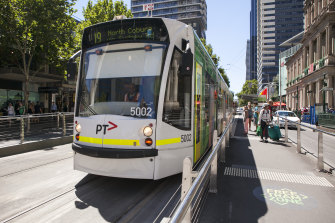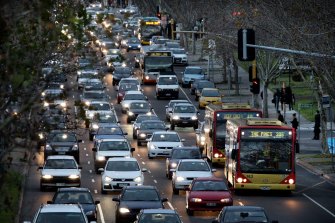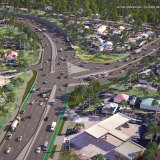Home » World News »
Stuck on a tram going nowhere? You may have hit one of Melbourne’s worst bottlenecks
The city’s worst public transport bottlenecks have been identified, prompting calls for buses and trams to be given more priority on Melbourne’s roads in a move that would shave thousands of hours off people’s commutes.
Monash University and RMIT academics said public transport must be favoured over cars on key roads through the city and around major universities and hospitals, adding to calls by Melbourne City Council, Yarra Trams and the Public Transport Users Association.
Experts say public transport should be given priority over cars on key city streets.
Failure to do this will result in Melbourne’s roads becoming increasingly overwhelmed by cars, the researchers said – exacerbating a traffic problem that has worsened on arterial roads since COVID-19, as commuters ditch public transport because of infection fears.
Melbourne’s worst public transport bottleneck is the corner of Swanston and La Trobe streets in the heart of the CBD, where 10 tram routes pass the State Library, RMIT and Melbourne Central, according to the academics. It means if a crash took place at this corner, it would impact the largest number of public transport commuters across the network.
Next on the list is the busy bus route on Hoddle Street between the Eastern Freeway and Johnston Street, followed by trams that run on Bridge Road, outside of Epworth Hospital, near Hoddle Street.
Fourth on the list are bus routes servicing thousands of university students on North Road, between Monash University’s Clayton campus and Huntingdale train station, where buses are the only public transport option.
Hai Vu, the director of Monash University’s Institute of Transport Studies, said trams and buses must be given dedicated lanes at the city’s worst bottlenecks.
But his research, which was published in international journal, Nature Communications, shows that even where there are dedicated lanes, like on Swanston Street and St Kilda Road, trams are still forced to wait at red lights, creating delays. Trams currently spend about 16 per cent of their time stuck at traffic lights.
Two thousand hours of travel time would be slashed from Melburnians’ public transport commutes during a single morning peak period if trams and buses were given more road and traffic signal priority, the research found. Eleven thousand hours of passenger travel time would be cut during a normal weekday.
Reliability would improve by 23 per cent on average during weekdays and by up to 26 per cent on weekends, according to the research.
Hoddle Street continues to be one of the worst traffic choke points.Credit:Angela Wylie
“This is not about saying this is a bad network, but we are saying this is the way you could improve it,” said Professor Vu.
“People will move towards using their cars because the experience of using public transport is bad. There are long delays and then you end up with more cars on the road and more congestion.”
An artist’s impression of the redesigned intersection at Fitzsimons Lane and Main Road in Eltham.Credit:Victorian government
Public Transport Users Association spokesman Tony Morton said his lobby group had for decades called for more public transport priority on Melbourne’s roads, yet suburban road upgrades were continuing to be built without dedicated lanes for buses and trams.
Upgrades to the Chandler Highway bridge and roads on the approach to Eltham’s Main Road and Fitzsimons Lane roundabout will triple the number of traffic lanes, but a dedicated bus lane will not be built.
Bus lanes on Williamsons Road and Fitzsimons Lane in Templestowe that gave priority to nearly 400 buses a day will be removed as part of the $2.2 billion northern roads upgrade.
These road upgrades should have included public transport priority lanes from the outset, Dr Morton said, as road expansions will attract more cars and ultimately worsen congestion, making it more difficult to give up car lanes to public transport down the track.
“Congestion is due to the presence of a large number of single-occupant vehicles in an urban area that’s only got a finite amount of space to move people,” Dr Morton said.
“We have the most efficient method of transport being delayed due to the lack of road priority.”
The drop in public transport use during COVID-19 was not a good reason to dismiss the need to upgrade the network, Dr Morton said.
The value of public transport was greater than simply getting people to and from the city for work, with many using it outside traditional hours and on weekends, he said.
Melbourne City Council’s 30-year transport plan – which called for road and traffic light priority for buses and trams in the city – showed most street space in the city was taken up by cars, despite motor vehicles being the least efficient transport mode.
Cars take up 9.2 square metres per person, compared with 0.6 square metres for trams and 0.5 square metres per person for trains, Melbourne Council’s research found.
The majority of Melbourne’s trams share road space with cars, with 40 per cent of collisions, falls and near misses on trams occurring where there is poor separation from cars, such as plastic strips and where painted lines are installed.
There are only two full-time bus lanes in the city – Victoria and Spring streets – and a small number of peak-hour lanes on Queen, Hoddle and Lonsdale streets.
Public transport service provision per capita has declined since 2011-12, according to the Public Transport Research Group.
An Andrews government spokeswoman said a 2019 traffic signal trial that gave priority to trams running two minutes late or more on the 75 tram route along Toorak Road and the Burwood Highway was ongoing.
It comes as the government starts a review of traffic light signals, analysing and updating traffic sequencing at 759 traffic signals at 170 intersections to optimise traffic flow. The review factors in public transport priority.
The spokeswoman pointed to new public transport projects that would ease bottlenecks, including the construction of a dedicated bus lane along the Eastern Freeway as part of the $16 billion North East Link and the $13.7 billion Metro Tunnel, which would enable more than half a million additional passengers to use the network during peak periods every week.
“As Victorians get back out on our roads and public transport network, we’re delivering an unprecedented $340 million package to reduce congestion for all travellers – and that includes work to improve the system that determines priority for public transport,” the spokeswoman said.
“We’re running trials to give priority to public transport vehicles on our roads when they’re running behind schedule – so we can make services more reliable and ease bottlenecks across our network.”
Start your day informed
Our Morning Edition newsletter is a curated guide to the most important and interesting stories, analysis and insights. Sign up here.
Most Viewed in National
From our partners
Source: Read Full Article





